 For the majority of people, a house (or flat) is the most valuable thing they will ever own.
For the majority of people, a house (or flat) is the most valuable thing they will ever own.
It is important to understand the role that house prices play in the economy and how much of an impact they have.
The Bank of England monitors changes in the housing market to assess the risks to the financial system and the wider economy. The housing market employs large numbers of people in construction, sales, furniture and fittings, and accounts for a sizeable percentage of the value of GDP. The market is closely linked to consumer spending and therefore is a crucially important sector of the economy.
The concepts of supply and demand can be applied to understand house price changes and the impacts on the economy.
What is the housing market?
The housing market brings together different stakeholders, such as homeowners who are selling their properties, people seeking to buy a property, renters, investors who buy and sell properties solely for investment purposes, contractors, renovators and estate agents, who act as facilitators in the process of buying or selling a property.
In the UK, two-thirds of households own the property in which they live, and the remaining third of households are renters, split fairly equally between private and social renting. We can thus divide people into:
- Homeowners – either outright owners or with a mortgage;
- Private renters – people renting from private landlords;
- Social renters – people renting from local authorities and housing associations.
There are many determinants of demand and supply in the housing market, many of which are related to demographic factors. Such factors include the size of the market, rate of marriages, divorces, and deaths. However, factors such as income, availability of credit, interest rates and consumer preferences are also important.
Why is the housing market important for the economy?
 Changes in the housing market are always given such importance due to the relationship house prices have with consumer spending. Changes in house prices and the number of sales affect how much money people have to spend. Given that household spending accounts for two-thirds of Britain’s total economic activity, any changes in consumption is likely to have a major impact on the wider economy. Observing the housing market helps us to assess the overall demand for goods and services.
Changes in the housing market are always given such importance due to the relationship house prices have with consumer spending. Changes in house prices and the number of sales affect how much money people have to spend. Given that household spending accounts for two-thirds of Britain’s total economic activity, any changes in consumption is likely to have a major impact on the wider economy. Observing the housing market helps us to assess the overall demand for goods and services.
When house prices increase, those consumers who own their own homes have now become better off as their houses are worth more. This ‘wealth effect’ increases the confidence of homeowners, which in turn increases consumption. Some of these homeowners will decide to acquire additional borrowing against the value of their home. The borrowing is then spent in the economy on goods and services, thereby increasing aggregate demand and GDP.
However, when house prices decline, homeowners lose confidence as their home is now worth less than before. This becomes a major issue if prices have decreased enough to make their house worth less than the remainder of the unpaid mortgage – known as ‘negative equity’. Homeowners will therefore reduce their consumption and will be less likely to undertake any new borrowing.
The vast majority of homeowners will have taken out a mortgage in order to purchase their home. Mortgages are the largest source of debt for households in the UK. More than 70% of household borrowing is mortgage debt. Half of all homeowners who live in the house they own are still paying off their mortgage. Therefore, households might suddenly hold back on their spending during times of uncertainty because they start to worry about repaying their debts. This has a knock-on effect on the rest of economy, and a small problem can suddenly become a big one.
In addition to affecting overall household spending, the buying and selling of houses also affects the economy directly. Housing investment is a small but unpredictable part of total output in the economy. There are two different ways in which the buying and selling of houses impacts GDP.
 The first is when a new build is purchased. This directly contributes to GDP through the investment in the land to build the house on, the purchase of materials and the creation of jobs. Once the homeowners move in they also contribute to the local economy: i.e. shopping at local shops.
The first is when a new build is purchased. This directly contributes to GDP through the investment in the land to build the house on, the purchase of materials and the creation of jobs. Once the homeowners move in they also contribute to the local economy: i.e. shopping at local shops.
The second is when an existing home is bought or sold. The purchase of an existing home does not have the same impact on GDP. However, it does still contribute to GDP: i.e. from estate agents’ and solicitors’ fees and removal costs to the purchase of new furniture.
Why house prices change: demand and supply
Demand: the demand for housing can be defined as the quantity of properties that homebuyers are willing and able to buy at a given price in a given time period. Factors affecting the demand for housing include:
- Real incomes: If real incomes increase the demand for housing increases due to a rise in the standard of living.
- The cost of a mortgage: If there is a rise in interest rates in the economy, mortgage interest rates are likely to rise too. This makes the cost of financing a loan more expensive and therefore will see a decline in demand.
- Availability of credit: The more lending banks and building societies are willing to provide, the more people will borrow and spend on housing and hence the higher house prices will be.
- Economic growth: When the economy is in the recovery and boom stages of the business cycle, wages rise. This will increase the demand for houses.
- Population: When the population increases or if there is an increase in single-person households, demand for housing increases.
- Employment/unemployment: The higher the level of unemployment in an economy, the less people will able to afford housing.
- Confidence: If consumers feel optimistic about the future state of the economy, they will be more likely to go ahead with purchasing a house, thereby increasing demand. House prices tend to rise if people expect to be richer in the future.
Supply: The supply of housing can be defined as the flow of properties available at a given price in a given time period. The supply of housing includes both new-build homes and existing properties. Factors affecting the supply for housing include:
- Costs of production: The higher the cost of production, the fewer houses are built, reducing the supply of housese coming to the market. Example of costs include: labour costs, land for development and building materials.
- Government policy: If the government increases taxation and/or reduces subsidies for new house developments, there will be fewer new houses built.
- Number of construction companies: Depending on their objectives, the more construction companies there are, the more likely there is to be an increase in the supply of housing. The construction industry accounts for around 7% of UK GDP.
- Technology and innovation: With improved technology and innovation in the construction industry, houses become cheaper and easier to build, thus increasing the supply.
- Government spending on building new social housing: The government has the ability to influence the supply of housing by increasing spending on new social housing.
Price elasticity of supply
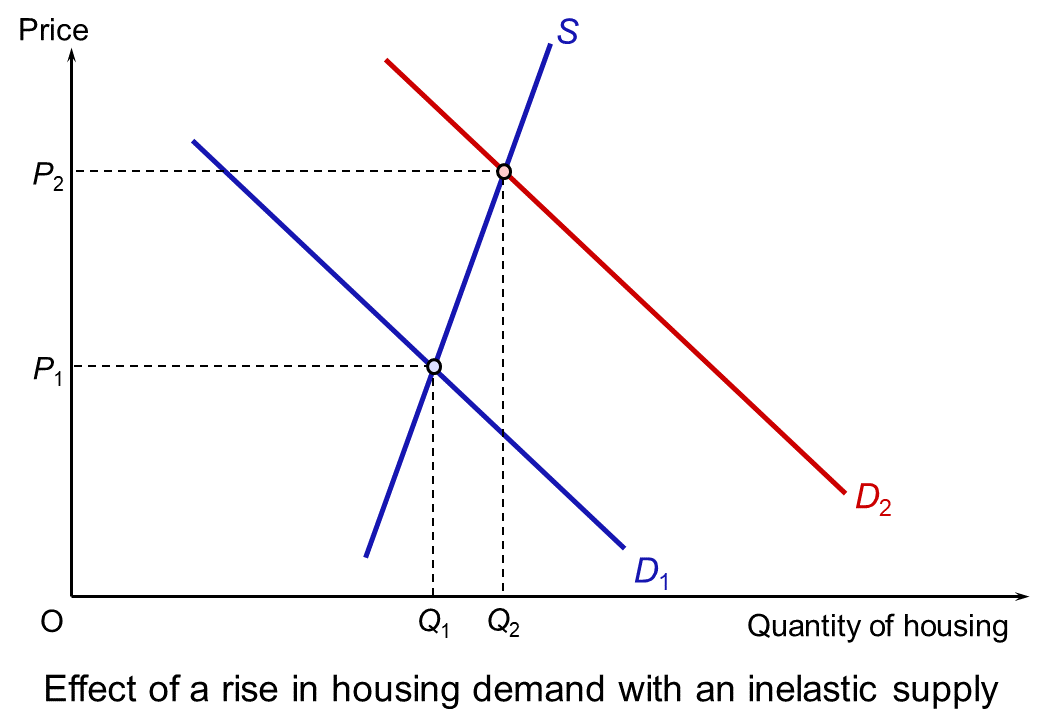 The supply of new housing in the short run is price inelastic. The main reason for this is the time it takes to build a new home. The production of a house can take many months, from the planning process to the project’s completion. Supply also relies on access to a skilled labour force and the availability of certain construction materials.
The supply of new housing in the short run is price inelastic. The main reason for this is the time it takes to build a new home. The production of a house can take many months, from the planning process to the project’s completion. Supply also relies on access to a skilled labour force and the availability of certain construction materials.
Because of the inelastic supply, any changes in demand are likely to have a significant effect on price. This is illustrated by the diagram, which shows a larger proportionate increase in price than quantity when demand increases from D1 to D2.
The current UK housing market
Despite the current economic climate and the effects of the lockdown restrictions on consumers, house prices have increased, and sales have now resumed. Rightmove, which advertises 95% of homes for sale, states that the housing market has seen its busiest month in more than 10 years in July. During the summer, the housing market usually sees a lull in activity. However, since the easing of lockdown, there has been a flurry of activity from buyers and sellers. Since July 2019, house prices have increased by 1.7%, according to the Nationwide Building Society.
 London estate agency, Hamptons, states that homeowners are now bringing forward their moving plans as the experience of lockdown has encouraged them to seek more space. The mortgage market is also very favourable right now in terms of interest rates, and rental demand is continuing to surge across the UK.
London estate agency, Hamptons, states that homeowners are now bringing forward their moving plans as the experience of lockdown has encouraged them to seek more space. The mortgage market is also very favourable right now in terms of interest rates, and rental demand is continuing to surge across the UK.
The increase in activity in the market has also been helped by the announcement of a stamp duty ‘holiday’ until March 2021. This sees the threshold above which stamp duty is paid rising from £125 000 to £500 000. Estate agency, Savills, has also seen an increase in the number of new buyers registering with its service, more than double the number registered in July 2019. It is thought that, along with the tax savings from stamp duty, people’s experiences in lockdown have made them evaluate their current living space and reconsider their housing needs.
However, given the that the economy is experiencing its deepest recession on record, there is concern about just how long the market can resist the economic forces pulling prices down.
Historically, a drop in house prices has been both a cause and a consequence of economic recessions. During the 2008 financial crisis, house prices fell by about 30%. As previously mentioned, for the majority of people, a house is the most valuable thing they will ever own and therefore consumers are extremely interested in its value. Consumer confidence is one of the key factors affecting the demand for housing. If consumers feel pessimistic about the future state of the economy, they will be less likely to go ahead with purchasing a house, thereby decreasing demand. Britain’s Office for Budget Responsibility, the country’s fiscal watchdog, forecasts that during this downturn prices will fall 5% this year and 11% in 2021.
Various government schemes put in place to help during lockdown are starting to come to an end. The main one – the furlough scheme, which replaced 80% of eligible workers’ incomes – comes to an end in October. It is forecast that labour market conditions will weaken significantly in the quarters ahead, with unemployment predicted to rise for the rest of the year. If these predictions materialise, it would likely dampen housing activity once again.
Conclusion
Fluctuations in house prices and transactions tend to amplify the volatility of the economic cycle. Therefore, it is crucial that we understand what influences such changes. Understanding how supply and demand factors influence the housing market can enable key stakeholders to make better predictions about future activity and plan accordingly. The current market has seen a growth since the easing of restrictions but there is concern that this has been powered by pent-up demand. Therefore, the outlook for house prices is uncertain and the full effects of an economic downturn are yet to be realised.
Articles
Questions
- Explain why the supply of housing is inelastic in the short-term.
- Given that the elasticity of housing supply in the UK is low, what policies could be introduced to ensure that house building is more responsive to changes in market demand?
- If unemployment does increase as predicted, explain what impact this would have on the demand in the housing market and house prices? Use a supply and demand diagram to aid your answer.
- Explain how changes in house prices affect the government’s key macroeconomic objectives.
 How to get the most from your money? This is the question posed by the linked article below. It’s a topic we’ve looked at in previous posts, such as Studies show that money can buy happiness (but only if you spend on experiences), Happiness economics and Peak stuff. This article takes the arguments further.
How to get the most from your money? This is the question posed by the linked article below. It’s a topic we’ve looked at in previous posts, such as Studies show that money can buy happiness (but only if you spend on experiences), Happiness economics and Peak stuff. This article takes the arguments further.
It suggests that, up to a certain level of income, there is a roughly linear relationship between money and life satisfaction. As poor people have more to spend, so they can begin to escape poverty and the negative features of financial insecurity and a lack of basic necessities, such as food and shelter. They also gain a greater freedom to choose what and when to buy. Beyond a certain level, however, the rate of increase in life satisfaction tends to decline, as does the specific pleasure from additional individual purchases. In economists’ language, the marginal utility of income diminishes.
But the article goes further than this. It suggests that satisfaction or happiness is of two broad types. The first is the general sense of well-being that people get from their life. This tends to be relatively stable for any given person, but will tend to increase as people have more money to spend or have more fulfilling jobs. Of course, there may well be a trade-off between income and job satisfaction. Some people may prefer to take a cut in pay for a more fulfilling job.
 The second is the satisfaction or happiness you get from specific experiences. This tends to fluctuate on a day-to-day basis, depending on what you are doing. Here, what you purchase and the use you make of the purchases is a key component.
The second is the satisfaction or happiness you get from specific experiences. This tends to fluctuate on a day-to-day basis, depending on what you are doing. Here, what you purchase and the use you make of the purchases is a key component.
So what lessons are there for earning and spending money wisely? To start with, it is important to get a good work-life balance. It may be worth trading income for job satisfaction. Here the focus should be on long-term fulfilment, rather than on the short-term happiness from more ‘stuff’. Then it is important to spend money wisely. Here the author identifies three lessons:
The first is to consider buying time. Time-saving purchases, such as dishwashers can help. So too can ‘outsourcing’ activities, such as cleaning, laundry, cooking, DIY or child care, if they give you more time to do other more fulfilling things (but not if you love doing them!).
 The second is to spend more money on experiences (as we saw in the post Studies show that money can buy happiness (but only if you spend on experiences). A better TV or car may seem like a wiser investment than more dinners out, holidays or going to concerts. But we quickly adapt to new upgraded ‘stuff’, thereby eliminating any additional satisfaction. Experiences, however, tend to linger in the memory. As Tom Gilovich, a psychology professor at Cornell University, is quoted by the article as saying:
The second is to spend more money on experiences (as we saw in the post Studies show that money can buy happiness (but only if you spend on experiences). A better TV or car may seem like a wiser investment than more dinners out, holidays or going to concerts. But we quickly adapt to new upgraded ‘stuff’, thereby eliminating any additional satisfaction. Experiences, however, tend to linger in the memory. As Tom Gilovich, a psychology professor at Cornell University, is quoted by the article as saying:
Even though, in a material sense, they [experiences] come and go, they live on in the stories we tell, the relationships we cement, and ultimately in the sense of who we are.
Choosing a more fulfilling but less well-paid job is a form of spending money on experiences.
The third is to give some of your money away, whether to charity or to helping friends or relatives. As Gilovich says:
It’s hard to find a more charming finding than that by giving away money, you not only make someone else happier, you make yourself happier.
Article
Questions
- What is meant by ‘diminishing marginal utility of income’? Is the concept consistent with the arguments in the article?
- In what sense may it be rational to choose a lower-paid job?
- Is ‘happiness’ the same as ‘utility’ as the concept is used by economists?
- Does the concept of ‘peak stuff’ apply to all physical products? Explain your answer.
- If giving money away makes a person happy, is it truly altruistic for that person to do so? Explain.
 With the effects of the depreciation of sterling feeding through into higher prices, so the rate of inflation has risen. The latest figures from the ONS show that in the year to April 2017, CPI inflation was 2.7% – up from 2.3% in the year to March. The largest contributors to higher prices were transport costs and housing and household services.
With the effects of the depreciation of sterling feeding through into higher prices, so the rate of inflation has risen. The latest figures from the ONS show that in the year to April 2017, CPI inflation was 2.7% – up from 2.3% in the year to March. The largest contributors to higher prices were transport costs and housing and household services.
But wage increases are not keeping up with price increases. In 2017 Q1, the average annual growth rate in regular pay (i.e. excluding bonuses) was 2.1%. In other words, real pay is falling. And this is despite the fact that the unemployment rate, at 4.6%, is the lowest since 1975.
The fall in real wages is likely to act as a brake on consumption and the resulting dampening of aggregate demand could result in lower economic growth. On the other hand, the more buoyant world economy, plus the lower sterling exchange rate is helping to boost exports and investment and this could go some way to offsetting the effects on consumption. As Mark Carney stated in his introductory remarks to the May 2017 Bank of England Inflation Report:
The combination of the stronger global outlook and sterling’s past depreciation is likely to support UK net trade. And together with somewhat lower uncertainty, stronger global growth is also likely to encourage investment as exporters renew and increase capacity.
According to the Bank of England, the net effect will be modest economic growth, despite the fall in real wages.
In the MPC’s central forecast, quarterly growth is forecast to stabilise around its current rate, resulting in growth of 1.9% in 2017 and around 1¾% in each of the next two years.
 But forecasting is dependent on a range of assumptions, not least of which are assumptions about consumer and business expectations. These, in turn, depend on a whole range of factors, such as the outcome of the UK election, the Brexit negotiations, commodity prices, world growth rates and international events, such as the actions of Donald Trump. Because of the uncertainty surrounding forecasts, the Bank of England uses fan charts. In the two fan charts illustrated below (from the May 2017 Inflation Report), the bands on constructed on the following assumptions:
But forecasting is dependent on a range of assumptions, not least of which are assumptions about consumer and business expectations. These, in turn, depend on a whole range of factors, such as the outcome of the UK election, the Brexit negotiations, commodity prices, world growth rates and international events, such as the actions of Donald Trump. Because of the uncertainty surrounding forecasts, the Bank of England uses fan charts. In the two fan charts illustrated below (from the May 2017 Inflation Report), the bands on constructed on the following assumptions:
If economic circumstances identical to today’s were to prevail on 100 occasions, the MPC’s best collective judgement is that CPI inflation or the mature estimate of GDP growth would lie within the darkest central band on only 30 of those occasions and within each pair of the lighter coloured areas on 30 occasions.
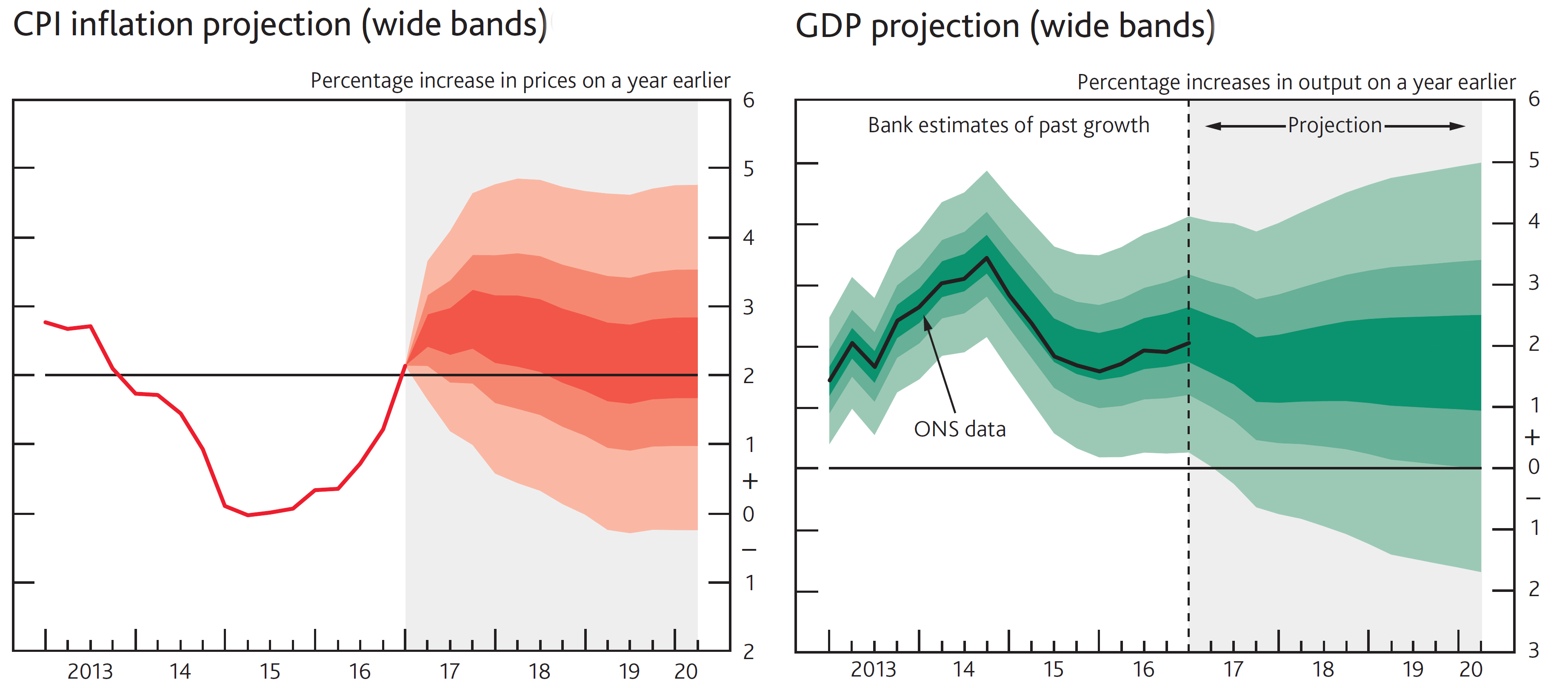
The charts and tables showing the May 2017 projections have been conditioned on the assumptions that the stock of purchased gilts remains at £435 billion and the stock of purchased corporate bonds remains at £10 billion throughout the forecast period, and on the Term Funding Scheme (TFS); all three of which are financed by the issuance of central bank reserves. They have also been conditioned on market interest rates, unless otherwise stated.
The wider the fan, the greater the degree of uncertainty. These fan charts are wide by historical standards, reflecting the particularly uncertain future for the UK economy.
But one thing is clear from the latest data: real incomes are falling. This is likely to dampen consumer spending, but just how much this will impact on aggregate demand over the coming months remains to be seen.
Articles
UK real wages drop for first time in three years Financial Times, Sarah O’Connor (17/5/17)
Bank of England warns Brexit vote will damage living standards The Guardian, Katie Allen (11/5/17)
UK wage growth lags inflation for first time since mid-2014 BBC News (17/5/17)
Britons’ Falling Real Wages Show Challenging Times Have Arrived Bloomberg, Scott Hamilton and Lucy Meakin (17/5/17)
Jobs market will suffer a Brexit slowdown, say experts The Guardian, Angela Monaghan and Phillip Inman (15/5/17)
Pay will continue to be squeezed, employers’ survey suggests BBC News, Kamal Ahmed (15/5/17)
Brexit latest: Real wages falling, Office for National Statistics reveals Independent, Ben Chu (17/5/17)
UK inflation climbs to four-year high, beating forecasts Financial Times, Gavin Jackson (16/5/17)
Why is UK inflation at a four-year high? Financial Times, Gavin Jackson (19/5/17)
A blip, or a test of hawks’ patience? Economists respond to high UK inflation data Financial Times, Nicholas Megaw (16/5/17)
UK inflation rate at highest level since September 2013 BBC News (16/5/17)
Inflation jumps to its highest level since 2013 as Brexit continues to bite Business Insider, Will Martin (16/5/17)
UK GDP growth weaker than expected as inflation hits spending The Guardian, Katie Allen (25/5/17)
UK economic growth estimate revised down BBC News (25/5/17)
Reports
Inflation Report, May 2017 Bank of England (11/5/17)
Labour Market Outlook, Sping 2017 Chartered Institute of Personnel and Development (May 2017)
Data
Statistical Interactive Database – interest & exchange rates data Bank of England
Inflation and price indices ONS
Earnings and working hours ONS
Second estimate of GDP: Jan to Mar 2017 ONS Statistical Bulletin (25/5/17)
Questions
- Find out what has happened to the dollar/sterling and the euro/sterling exchange rate and the sterling exchange rate index over the past 24 months. Plot the data on a graph.
- Explain the changes in these exchange rates.
- Why is there negative real wage growth in the UK when the rate of unemployment is the lowest it’s been for more than 40 years?
- Find out what proportion of aggregate demand is accounted for by household consumption. Why is this significant in understanding the likely drivers of economic growth over the coming months?
- Why is uncertainty over future UK growth rates relatively high at present?
- Why is inflation likely to peak later this year and then fall?
- What determines the size and shape of the fan in a fan chart?
 Household borrowing on credit cards and through overdrafts and loans has been growing rapidly. This ‘unsecured’ borrowing is now rising at rates not seen since well before the credit crunch of 2008 (click here for a PowerPoint of the chart below). Should this be a cause for concern?
Household borrowing on credit cards and through overdrafts and loans has been growing rapidly. This ‘unsecured’ borrowing is now rising at rates not seen since well before the credit crunch of 2008 (click here for a PowerPoint of the chart below). Should this be a cause for concern?
Household confidence is generally high and, as a result, people continue to take out more loans and so household debt continues to increase. Saving rates are falling and, at 5.1% of household disposable income, are the lowest rate since 2008, mirroring the high levels of spending and borrowing.
But as long as the economy keeps growing and as long as interest rates stay at record low levels, people should be able to continue servicing this rising debt. Indeed, with generous balance transfer offers between credit cards and many people paying off their full balance each month, only 56.6% are paying any interest at all on credit card debt, the lowest level on record.
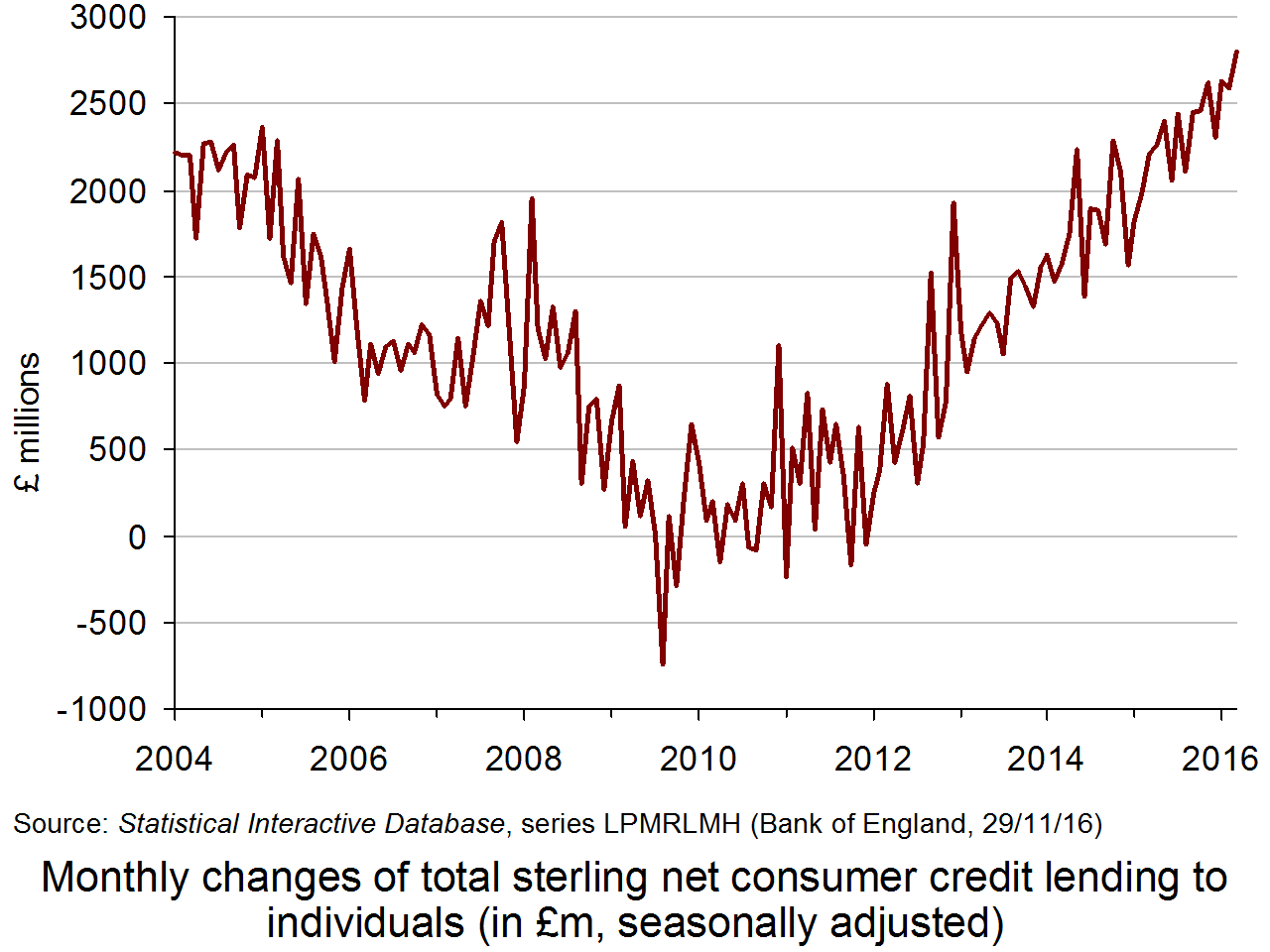 But there could be trouble ahead! Secured borrowing (i.e. on mortgages) is at record highs as house prices have soared, limiting the amount people have to left to spend, even with ultra low interest rates. Student debt is growing, putting a brake on graduate spending.
But there could be trouble ahead! Secured borrowing (i.e. on mortgages) is at record highs as house prices have soared, limiting the amount people have to left to spend, even with ultra low interest rates. Student debt is growing, putting a brake on graduate spending.
With economic growth set to slow and inflation set to rise as the effects of the lower pound filter through into retail prices, this could initially boost borrowing further as people seek to maintain levels of consumption. But then, if unemployment starts to rise and consumer confidence starts to fall, real spending could decline, putting further downward pressure on the economy.
Confidence could then fall further and we could witness a repeat of 2008–9, when people became worried about their levels of borrowing and cut back on consumption in an attempt to claw down their debt. The economy was pushed into recession.
The Bank of England is well aware of this scenario and wants banks to ensure that their customers can afford loans before offering them.
Articles
Bank governor Mark Carney warns on household debt BBC News, Brian Milligan (30/11/16)
Credit crunch: Household debt is rising just as the economy’s future is uncertain The Telegraph, Tim Wallace (10/12/16)
Bank of England publication
Financial Stability Report, November 2016 Bank of England (30/11/16)
Data
Money and lending Bank of England Interactive Database
United Kingdom Households Debt To GDP Trading Economics
Household debt OECD Data
Questions
- What determines the amount people borrow?
- What would cause people to cut back on the amount of debt they have?
- Distinguish between secured and unsecured borrowing and debt.
- Why has secured borrowing risen? Does this matter?
- What is meant by the term ‘re-leveraging’? What is its significance in terms of household borrowing?
- Find out what the affordability tests are for anyone wanting to take out a mortgage.
- What are the greatest risks to UK financial stability?
 We have frequently looked at patterns in lending by financial institutions in our blogs given that many economies, like the UK, display cycles in credit. Central banks now pay considerable attention to the possibility of such cycles destabilising economies and causing financial distress to people and businesses. There is also increased interest here in the UK in bank lending data in light of Brexit. Patterns in credit flows may indicate whether it is affecting the lending choices of financial institutions and borrowing choices of people and businesses.
We have frequently looked at patterns in lending by financial institutions in our blogs given that many economies, like the UK, display cycles in credit. Central banks now pay considerable attention to the possibility of such cycles destabilising economies and causing financial distress to people and businesses. There is also increased interest here in the UK in bank lending data in light of Brexit. Patterns in credit flows may indicate whether it is affecting the lending choices of financial institutions and borrowing choices of people and businesses.
Data from the Bank of England’s Money and Credit – September 2016 statistical release shows net lending (lending net of repayments) by monetary financial institutions (MFIs) to individuals in September 2016 was £4.65 billion. This compares with £8.89 billion back in March 2016 which then was the highest monthly total since August 2007. However, the March figure was something of a spike in lending and this September’s figure is actually very slightly above the monthly average over the last 12 months, excluding March, of £4.5 billion. In other words, as yet, there is no discernible change in the pattern of credit flows post-Brexit.
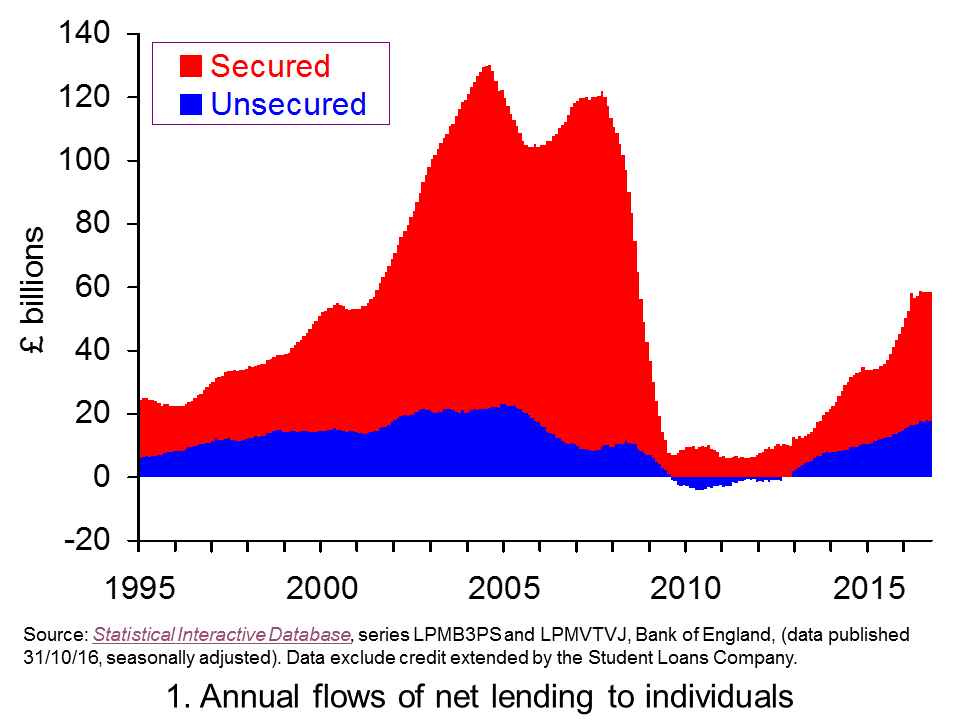 Leaving aside the question of the economic impact of Brexit, we still need to consider what the credit data mean for financial stability and for our financial well-being. Chart 1 shows the annual flows of lending by banks and building societies since the mid 1990s. The chart evidences the cycles in secured lending and in consumer credit (unsecured lending) with its consequent implications for economic and financial-welling being.(Click here to download a PowerPoint of Chart 1.)
Leaving aside the question of the economic impact of Brexit, we still need to consider what the credit data mean for financial stability and for our financial well-being. Chart 1 shows the annual flows of lending by banks and building societies since the mid 1990s. The chart evidences the cycles in secured lending and in consumer credit (unsecured lending) with its consequent implications for economic and financial-welling being.(Click here to download a PowerPoint of Chart 1.)

After the financial crisis, as Chart 1 shows, net lending to individuals collapsed. More recently, net lending has been on the rise both through secured lending and in consumer credit. The latest data show that annual flows have begun to plateau. Nonetheless, the total flow of credit in the 12 months to September of £58 billion compares with £33 billion and £41 billion in the 12 months to September 2014 and 2015 respectively. Having said this, in the 12 months to September 2007 the figure was £112 billion! £58 billion is currently equivalent to around about 3 per cent of GDP.
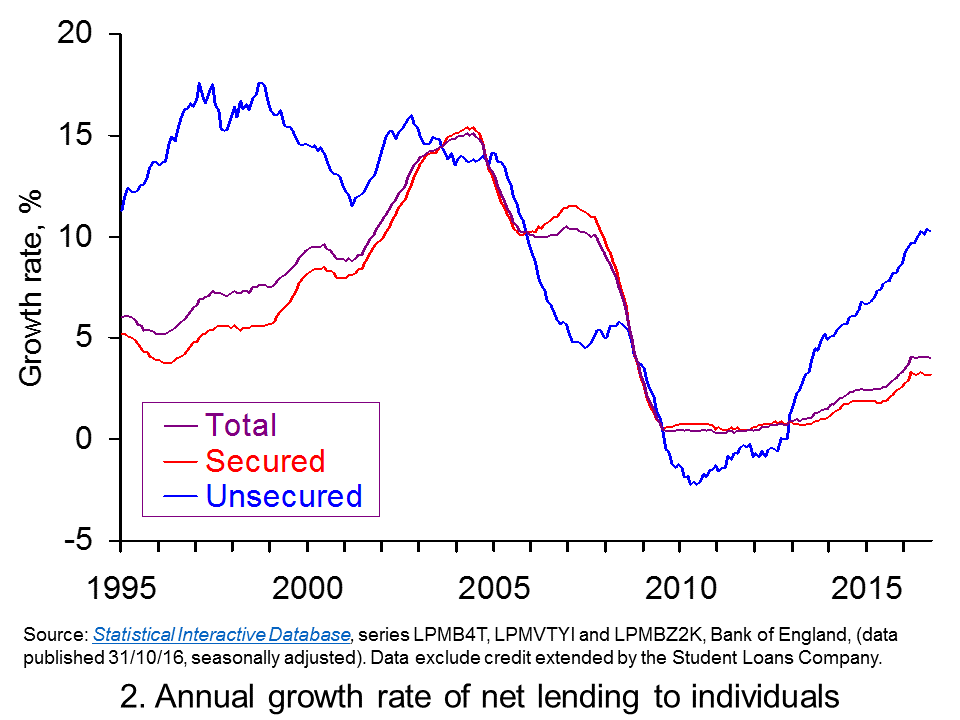 To more readily see the effect of the credit flows on debts stocks, Chart 2 shows the annual growth rate of net lending by MFIs. In essence, this mirrors the growth rate in the stocks of debt which is an important metric of financial well-being. The chart nicely captures the pick up in the growth of lending from around the start of 2013. What is particularly noticeable is the very strong rates of growth in net unsecured lending from MFIs. The growth of unsecured lending remains above 10 per cent, comparable with rates in the mid 2000s. (Click here to download a PowerPoint of Chart 2.)
To more readily see the effect of the credit flows on debts stocks, Chart 2 shows the annual growth rate of net lending by MFIs. In essence, this mirrors the growth rate in the stocks of debt which is an important metric of financial well-being. The chart nicely captures the pick up in the growth of lending from around the start of 2013. What is particularly noticeable is the very strong rates of growth in net unsecured lending from MFIs. The growth of unsecured lending remains above 10 per cent, comparable with rates in the mid 2000s. (Click here to download a PowerPoint of Chart 2.)
The growth in debt stocks arising from lending continues to demonstrate the need for individuals to be mindful of their financial well-being. This caution is perhaps more important given the current economics uncertainties. The role of the Financial Policy Committee in the UK is to monitor the financial well-being of economic agents in the context of ensuring the resilience of the financial system. It therefore analyses the data on credit flows and debt stocks referred to in this blog along with other relevant metrics. At this moment its stance is not to apply any additional buffer – known as the Countercyclical Capital Buffer – on a financial institution’s exposures in the UK over and above internationally agreed standards. Regardless, the fact that it explicitly monitors financial well-being and risk shows just how significant the relationship between the financial system and economic outcomes is now regarded.
Articles
Higher inflation and rising debt threaten millions in UK The Guardian, Angela Monaghan (5/11/16)
Consumer spending has saved the economy in the past – but we cannot bet on it forever Sunday Express, Geff Ho (13/11/16)
Warning as household debts rise to top £1.5 trillion BBC News, Hannah Richardson (7/11/16)
Household debt hits record high – How to get back on track if you’re in the red Mirror, Graham Hiscott (7/12/16)
Data
Money and Credit – September 2016 Bank of England
Bankstats (Monetary and Financial Statistics) – Latest Tables Bank of England
Statistical Interactive Database Bank of England
Questions
- Explain the difference between secured debt and unsecured debt.
- What does it mean if individuals are financially distressed?
- How would we measure the financial well-being of individuals and households?
- What actions might individuals take it they are financially distressed? What might the economic consequences be?
- How might uncertainty, such as that following the UK vote to leave the European Union, affect spending and savings’ decisions by households?
- What measures can institutions, like the UK’s Financial Policy Committee, take to reduce the likelihood that flows of credit become too excessive?
 For the majority of people, a house (or flat) is the most valuable thing they will ever own.
For the majority of people, a house (or flat) is the most valuable thing they will ever own. Changes in the housing market are always given such importance due to the relationship house prices have with consumer spending. Changes in house prices and the number of sales affect how much money people have to spend. Given that household spending accounts for two-thirds of Britain’s total economic activity, any changes in consumption is likely to have a major impact on the wider economy. Observing the housing market helps us to assess the overall demand for goods and services.
Changes in the housing market are always given such importance due to the relationship house prices have with consumer spending. Changes in house prices and the number of sales affect how much money people have to spend. Given that household spending accounts for two-thirds of Britain’s total economic activity, any changes in consumption is likely to have a major impact on the wider economy. Observing the housing market helps us to assess the overall demand for goods and services. The first is when a new build is purchased. This directly contributes to GDP through the investment in the land to build the house on, the purchase of materials and the creation of jobs. Once the homeowners move in they also contribute to the local economy: i.e. shopping at local shops.
The first is when a new build is purchased. This directly contributes to GDP through the investment in the land to build the house on, the purchase of materials and the creation of jobs. Once the homeowners move in they also contribute to the local economy: i.e. shopping at local shops.  The supply of new housing in the short run is price inelastic. The main reason for this is the time it takes to build a new home. The production of a house can take many months, from the planning process to the project’s completion. Supply also relies on access to a skilled labour force and the availability of certain construction materials.
The supply of new housing in the short run is price inelastic. The main reason for this is the time it takes to build a new home. The production of a house can take many months, from the planning process to the project’s completion. Supply also relies on access to a skilled labour force and the availability of certain construction materials.  London estate agency, Hamptons, states that homeowners are now bringing forward their moving plans as the experience of lockdown has encouraged them to seek more space. The mortgage market is also very favourable right now in terms of interest rates, and rental demand is continuing to surge across the UK.
London estate agency, Hamptons, states that homeowners are now bringing forward their moving plans as the experience of lockdown has encouraged them to seek more space. The mortgage market is also very favourable right now in terms of interest rates, and rental demand is continuing to surge across the UK.  How to get the most from your money? This is the question posed by the linked article below. It’s a topic we’ve looked at in previous posts, such as
How to get the most from your money? This is the question posed by the linked article below. It’s a topic we’ve looked at in previous posts, such as  The second is the satisfaction or happiness you get from specific experiences. This tends to fluctuate on a day-to-day basis, depending on what you are doing. Here, what you purchase and the use you make of the purchases is a key component.
The second is the satisfaction or happiness you get from specific experiences. This tends to fluctuate on a day-to-day basis, depending on what you are doing. Here, what you purchase and the use you make of the purchases is a key component. The second is to spend more money on experiences (as we saw in the post
The second is to spend more money on experiences (as we saw in the post 







